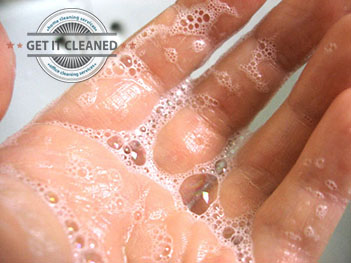They say cleanliness is next to godliness which shows the ancient origins of basic hygiene principles adopted by most people in the modern world. In the ancient Levant, a region rich in olive trees, soap making was a common practice. The soap recipe included olive oil, combined lye from wood ashes, and goat’s tallow, creating a soapy mixture that was effective for washing clothing. The first ever example of a cleaning agent so to say was water – a readily available natural resource in many early human settlements. People of the ancient world built their villages and towns near freshwater sources like rivers, wells or springs from which they drew water for drinking, cleaning and hygiene needs. The cleaning properties of water however are limited, perhaps it is better to say that water diluted and removed certain things like mud from hands and feet and food leftovers on dishes but that was about it. Actual use of cleaning agents, although naturally found ones did not happen until a later stage.
Soap – an interesting archaeological find

The word “soap” is believed to have been derived from Mount Sapo, an ancient Roman legend. The earliest example of soap ever found by archaeologists dates back to the year two thousand eight hundred BC, and comes from the ancient city of Babylon. Scientists unearthed a stash of sealed and labelled cylinder shaped canisters, indicating the vessels were full of soap like substance, as per the inscriptions ‘boiled with ashes’. Soap making using wood ashes was an early practice that involved combining melted animal fats or vegetable oils with alkaline salts to create a soapy mixture. This phrase is key to establish the authenticity of the canister contents as boiling ashes was one of the oldest known methods for making soap. However, the actual purpose of the ‘soap’ remains unknown. What is known though is that early soap was actually used as a hair styling products by some of the ancient peoples.
Another very early example of soap production and use, comes from ancient Egypt. Making and use of soap like substances is clearly described in the Ebers Papyrus – a medical document from about fifteen hundred BC. It is well known that Egyptians bathed on a regular basis, and used various cosmetics, including soap. The soap recipe described involves mixing vegetable oils with alkaline salts, creating a variety of soft soap products. The Ebers Papyrus actually goes as far as detailing the soap production method used by ancient Egyptians, which was to boil a mixture of vegetable and animal oils and natural alkaline salts. However, ancient Egyptian soap was not used for hygiene alone, but was also applied as treatment of certain skin conditions.
About the same time as the Egyptians were using their version of soap, supposedly Moses provided the Israelites with detailed personal cleanliness laws, amongst other regulations from above. This included instructions on the use of animal and vegetable oils in soap making. As per him, personal hygiene ensured healthier living and religious purification. It seems the Israelites took note because there are biblical references of their knowledge of soap making from fat and ash. Soap made from animal fat, particularly goat’s tallow, and vegetable oil was a common commodity. Initially though the substance they produced was used a hair styling product, just as ancient Babylonians did.
Soap in ancient Greece and Rome
Records from ancient Greece indicate that Greeks in the antiquity regularly bathed for health and aesthetic purposes. In their case though, they did not use soap, but rather a combination of the ingredients which go into making soap. It is believed that the Greeks were among the first to use olive oil in the creation of soap. Castile soap, which was made from olive oil and soda ash, was a common form of vegetable oil based soaps. What they did was to wet their skin, then scrub off impurities using blocks of clay, pumice, sand and ash. Next they rubbed oil over their body and scrapped the oil along with any dirt off their skin using a specially fashioned metal instrument called a strigil. Clothes however were washed using water only. Nevertheless, this shows that ancient Greeks too had the knowledge of soap and were aware of the cleaning properties of natural oils, salts and ashes.
Did Romans have Soap?

Historical myth has it that, the word ‘soap’ came from ancient Rome, much like many other things we enjoy today. And Yes, ancient Romans did have soap. According to the legend, there was a place called Mount Sapo – a site of religious sacrifice. The mountain was next to the Tiber River and when it rained, water running down the slope of the mountain brought a mix of wood ashes and tallow (melted animal fat) down to the strip of clay soil near the river.
Romans appreciated scented olive oils and started adding them to their soaps. The use of public baths also gained popularity. Women doing the laundry eventually noticed that the clay mixture found on the banks of the Tiber made their clothes much cleaner with less effort, so that was first time soap use in ancient Rome. Romans though did not stop there as once they realised the cleaning and health properties of using soap they made bathing a favourite past time. Roman baths were hugely popular for a period of time, and there were many bathhouses across the empire. The first Roman bath dates back to circa 312 BC, the water supply for many of the baths came from Rome’s famous aqueducts. At that time, bathing was fashionable and enjoyable at the same time. The famous Greek physician Galen officially proclaimed soap was good for both medicinal and hygiene purposes.
The Gauls and ancient Germanics…
These ferocious, untameable warriors of the north are also credited with discovering a soap like substance made of tallow and ashes, but they used it to dye their hair red…instead of washing up.
Setbacks in soap use
Much of the knowledge and civilizational advancements of ancient Greece and ancient Rome fell in oblivion after the downfall of the Roman Empire (west and east), a fate that also included personal hygiene and use of soap as means of washing up and keeping clean. After the fall of Rome, from about five hundred AD things like cleanliness, personal hygiene and bathing virtually disappeared from what was to become Europe in the Dark Ages. The commercial production of soap began to resurface during the Renaissance period. The soap recipe evolved, and synthetic detergents were developed. The sudden drop of hygiene resulted in massive slump of public health and wellbeing. The great plague outbreaks of medieval Europe were example of what happens when lack of hygiene and cleanliness are left to run rampant. Perhaps lack of hygiene is mostly attributed to the devastating plague outbreak of the fourteenth century. For the next three hundred years soap, bathing and washing were basically foreign concepts to most Europeans – it seemed cleanliness was no longer next to godliness. With advancements in technology and commerce, soap making saw a revival, and commercial production of soap including castile soap, made primarily from vegetable oil, flourished. Finally though, halfway through the sixteen hundreds being clean and smelling good was back into fashion again, and at last Europeans were once again washing and cleaning themselves. Perhaps one region of Europe where personal hygiene remained important during the dirty Middle Ages, was Iceland.
Common Types of Soap Used Today
| Kitchen Soaps (cleansers and detergents) | Medicated Soaps (antiseptics, disinfectants) |
| Laundry Soaps (liquid, gel and powder) | Glycerine Soaps |
| Cleaning soaps | Transparent Soap |
| Personal Hygiene Soaps (antibacterial) | Liquid Soaps |
| Novelty Soaps | – |
| Perfumed Soaps | – |
| Guest Soaps (the ones you find in hotels) | – |
| Beauty Soaps | – |

